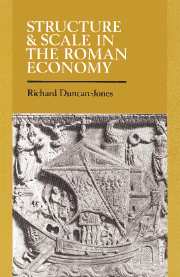Book contents
- Frontmatter
- Contents
- List of figures
- List of tables
- Preface
- List of abbreviations
- Introduction
- PART I TIME AND DISTANCE
- 1 Communication-speed and contact by sea in the Roman empire
- 2 Trade, taxes and money
- 3 Separation and cohesion in Mediterranean trade
- 4 Stability and change
- PART II DEMOGRAPHY AND MANPOWER
- PART III AGRARIAN PATTERNS
- PART IV THE WORLD OF CITIES
- PART V TAX-PAYMENT AND TAX-ASSESSMENT
- Appendices
- Bibliography
- Index
1 - Communication-speed and contact by sea in the Roman empire
Published online by Cambridge University Press: 13 October 2009
- Frontmatter
- Contents
- List of figures
- List of tables
- Preface
- List of abbreviations
- Introduction
- PART I TIME AND DISTANCE
- 1 Communication-speed and contact by sea in the Roman empire
- 2 Trade, taxes and money
- 3 Separation and cohesion in Mediterranean trade
- 4 Stability and change
- PART II DEMOGRAPHY AND MANPOWER
- PART III AGRARIAN PATTERNS
- PART IV THE WORLD OF CITIES
- PART V TAX-PAYMENT AND TAX-ASSESSMENT
- Appendices
- Bibliography
- Index
Summary
Change of emperor: a worm's eye view
‘The good genius of the world and source of all good things, Nero, has been declared Caesar. Therefore ought we all wearing garlands and with sacrifices of oxen to give thanks to all the gods’ (POxy 1021, 17 November AD 54).
Egypt has left far more documentary evidence than any other Roman province. One way in which its extraordinary wealth of data can throw light on communication-speed is by showing how long it took Egyptians to learn that one emperor had been replaced by another. The results can be compared with later Roman evidence for the travelling-time of Edicts (section 2), and with evidence for voyage-times from the Renaissance period (section 3).
Introduction
The emperor typically lived and died in central Italy. This meant that Egypt was not well placed for hearing of any change at an early stage. Nevertheless journeys to Alexandria of 6 and 7 days from Sicily and 9 days from Puteoli were recorded, though only as exceptional events. Typical delays in Egyptian awareness of change of emperor turn out to have been much longer, suggesting that even urgent news in practice travelled slowly to provinces overseas.
The most direct route from Rome to the Egyptian interior involved one journey by sea and another by river. Occasionally the two stages can be separated. Galba's accession was known in Alexandria by 6 July, within 27 days of Nero's death on 9 June AD 68.
- Type
- Chapter
- Information
- Structure and Scale in the Roman Economy , pp. 7 - 29Publisher: Cambridge University PressPrint publication year: 1990



